Biology
The exception to this is the recently discovered freshwater springs that also feed the Dead Sea. Along the sea bottom near these vents lives a multitude of Archaea (often called extremophiles) that used to be classified as bacteria, but are now known to be a different kingdom of life. Spreading along the seafloor, mats of Archaea form biofilms, previously unknown in the Dead Sea.
Some areas of Antarctica do support a little life; two vascular plants exist on the frozen continent, hair grass (Deschampsia antarctica) and the pearlwort (Colobanthus quitensis). These plants only grow on the west coast peninsula.
Other adaptations allow B. antarctica to thrive in this harsh environment. While the vast majority of plants and animals die with a relatively low level of dehydration (5-25%), these midges can survive a 70% water loss event - I suspect they can?t expectorate! In the winter?? WINTER? Isn?t it always winter there? Well, no; there is a colder season....the midge can react to winter by dehydrating and then coming back to life in the spring. Something like having a piece of beef jerky moo after you start salivating on it. Amazing.
Recent evidence shows just how adapted B. antarctica is for the dehydration. The midge has one genetic response to thermal stress, whether it be hot or cold. They turn off some pathways and increase glucose metabolism pathways.
But in dehydration, it has different responses to different patterns of dessication. If it is a rapid dehydration, glucose metabolism pathways are up regulated, but if it is slow and steady, a whole different set of pathways are upregulated, including those for different osmoprotectant molecules (trehelose and proline).
- Domains Of Life
The Three Domains of Life Eukarya: This is the most familiar domain to us because it is made up of the kingdoms animalia (animals), plantae (plants), fungi, and protista. They have a huge diversity when it comes to form but they all share fundamental...
- Atp: Cells
This is a picture of the sun :) The sun is the greatest form of energy for living organisms on earth. The sun gives of heat energy which is a form of ATP. Plants convert this energy for photosynthesis, the light is used to produce food for itself. The...
- 7. Ecosystem
Click here for PDFAn ecosystem is a functional unit of nature, where living organisms interact among themselves and also with the surrounding physical environment. Types of ecosystems· Terrestrial ecosystem: Forest, grassland, desert etc· ...
- I Am Your Density -- Life On Ice
Biology concepts ? density of water, latent heat, stratification Ernest Rutherford showed that atoms were mostly space by shooting alpha particles at a sheet of gold foil. Only a few particles struck something solid, most just passed straight through...
- Do You Drink Like A Fish?
Biology concepts ? fish osmoregulation, shark osmoregulation, semelparity, iteroparity The irony of fish drinking is not lost on this café in the Hotel Portofino at Universal Orlando. What I really like is the eye patch.You?d think that fish would never...
Biology
Water, Water Everywhere, But?.
Biology concepts ? symbiosis, mutualism, water storage
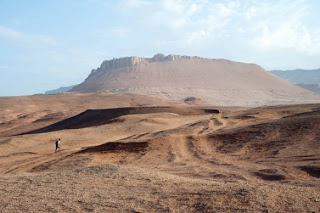 |
?Gobi? means desert in Ural-Altaic, so when you say, ?Gobi Desert,? you are really being redundant. |
Sometimes the places with the most water are the most lifeless areas. Everyone thinks of sand and heat, but Lawrence of Arabia wouldn?t even recognize most biological deserts.
The term biological desert is misleading, since places like the Gobi Desert in Asia support over 600 species of plants and hundreds of animal species, vertebrate and invertebrate. Death Valley in the USA has over 100 plants species; it could hardly be called dead! A biological desert has less to do with the climate and more to do with the adaptability of organisms to adverse conditions of oxygen, salt, water, light, or too often - pollution.
Take for instance the South Pacific Gyre. This area of about 34 million square kilometers (10 million sq. miles) has very little life in the pelagic zone (the below the surface waters to just above the sea floor). In the last posts we learned why water and salts are crucial for life, and the extreme evolutionary adaptations that have occurred in many organisms in order to conserve body water and maintain safe salt levels. But here we are in the ocean ? water everywhere, salt everywhere, but almost nothing lives in the gyre.
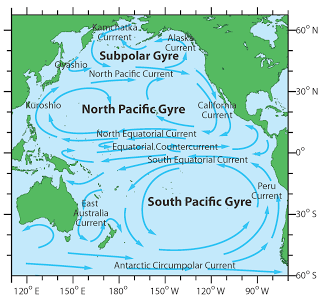 |
The north and south Pacific gyres represent a huge portion of the Earth?s surface, and these are relatively life free areas, the largest deserts on Earth. |
The reason for this paucity of life has more to do with nutrients than with water or salt. Because the current moves counter-clockwise, the center of the gyre is isolated from the upwelling of nutrients from the ocean floor, and the winds can?t help to churn the waters. Even if they could, it would help little. The waters of the gyre are rigidly layered due to salt and temperature differences (stratification, I Am Your Density), so nutrients find it difficult to travel to the surface from below. Adding to the problem, there is little landmass in the South Pacific, so windblown organic material and terrestrial runoff are limited. Nutrients are coming from neither above nor from below.
With limited nutrients, there is a ceiling to the amount of primary productivity of phytoplankton (phyto = plant, and planktos = wandering in Greek) that can take place. Fewer producers means that few primary consumers can be supported, and so forth up the food chain. Little life on the surface means few nutrients drop to the ocean floor (waste and dead organisms), and so on.
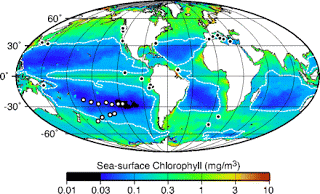 |
The ocean gyres have little upwelling if nutrients and therefore little plankton production. The bad news - with global climate change, the gyre-related low productivity zones are growing in size. |
Strangely enough, the lack of producers in the gyre has benefited humans in at least one aspect. The chlorophyll of the producers changes the color of the ocean, and this affects the trapping of heat and the wind currents. With a loss of living things in the North pacific gyre, a 2010 study states that typhoon formation has decreased in this region by more than 70%............Don?t get too excited, global surveying also says that the biological deserts of the gyres are growing much faster than global warming models would predict. As they grow, global productivity will be reduced, and that can?t be good for any of us.
We don?t make things any easier by letting chemicals run into the oceans either. Man made dead zones from increased nitrogen and phosphorous. These nutrients are needed for growing phytoplankton, but you can have too much of a good thing. The overgrowth of phytoplankton and algae in these areas, along with the decomposers they support, deplete O2. The result is that there is no oxygen left for succession organisms, so larger animals cannot live there (neither can the plankton or algae after a while).
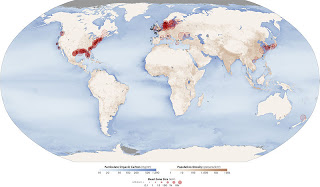 |
Man made dead zones correspond to areas of runoff from sprayed fields. For instance, the estuary of the Mississippi River in the Gulf of Mexico forms the second largest man made dead zone in the world each summer. Not to be outdone, the Baltic Sea dead zone in Northern Europe is the largest, and it is present all year round. |
So the gyres are ?almost dead? zones, and some polluted estuaries are considered dead zones. What about a body of water with dead in its name, the Dead Sea? At 423 meters (1388 feet) below sea level, the Dead Sea is officially the lowest body of water on Earth. Water flows into it, but not out of it, so all the salts and minerals just accumulate.
The temperature of the desert surrounding the Dead Sea is warm enough that evaporation plays a factor in increasing the salinity and mineral content of the remaining water. Only certain types of bacteria and algae can survive in the 33.7% saline waters (~8.6 x the salinity of the Mediterranean Sea).
Dunaliella salina algae are particularly abundant in the Dead Sea after the rainy season. These green algae produce antioxidant carotenoids to protect themselves from the intense sun exposure of the Jordan Rift Valley as well as huge amounts of glycerol (a three carbon carbohydrate) to counteract the osmotic pressure which would otherwise move all the freshwater out of the algal cells.
The algae is a good food source for halophilic (salt-loving) bacteria. However, during dry years, both the alga and bacteria are present in much lower numbers. But isn?t just the high salt that prevents larger plants and animals from living in the Dead Sea. The minerals that accumulate, such as magnesium chloride, calcium chloride, magnesium bromide, and calcium sulfate, are toxic to animals that drink the water. Fish from the freshwater feeders of the Dead Sea sometimes swim into the mineral-laden waters and are killed almost instantly.
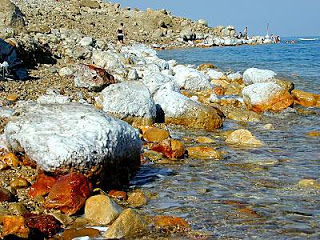 |
The Dead Sea has receded a mile in the past twenty years, and environmentalists warn it could be completely gone by 2050. As it recedes, it leaves salt on the rocks after the water evaporates. |
The Great Salt Lake in Utah is similar to the Dead Sea biologically, but the lower salinity (some places are 5% salt, while others are 25 %; a railroad causeway has separated it into a more saline north arm and less saline south arm) allows more types of organisms to thrive in the water. Still no fish, but more types of algae, as well as some brine shrimp and brine flies.
Surprisingly, there is abundant flora and fauna around both the Great Salt Lake and the Dead Sea. The Jordan Rift Valley boasts camels, leopards, and ibexes, as well as fig trees and the rose of Jericho. In the western hemisphere, the Great Salt Lake has millions of shore birds, mostly fed by the 100 billion brine flies that hatch each summer. It is just the exception that here you have to move away from the water to find the life.
The above two examples indicate areas that have a lot of water, but too much salt for it to be useful. There is another place on Earth that has plenty of H2O, but not enough liquid water to support much life ? does that make sense?
Antarctica. It is hard to believe that with all that ice, miles thick in some places, there is not enough free water to keep plants and animals alive, but in many parts of the continent, that is the case.
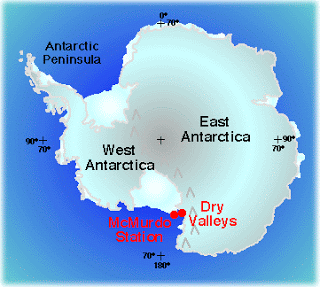 |
McMurdo Station is the largest community on Antarctica, if you don?t count the penguins. It is located near the McMurdo Dry Valleys, the driest places on Earth. This is due to the katabatic winds. Cold air is more dense, and is pulled downhill. The wind can reach speeds of 200 mph, and as it warms, it evaporates all the moisture on the ground and in the air. |
In the McMurdo Dry Valleys, east of McMurdo Station and the Ross ice sheet, almost nothing grows. There are hypersaline lakes here that put the Dead Sea to shame, including the Don Juan Pond that is 18x the salinity of the ocean.
There are no vertebrate animals in the valleys; microbes make up all the biology there. In all of Antarctica, only 67 species of insect are found, and most of these live as parasites on penguins.
The exception is the wingless midge (Belgica antarctica). At an average of 6 mm long, this fly is the largest purely terrestrial and year-round animal on the entire continent (penguins only live on the continent for part of the year). This flightless fly relative lives in algae mats, on rocks, and in the mud? just about anywhere it wants to. There are no competitors on Antarctica; this walking fly reigns supreme!
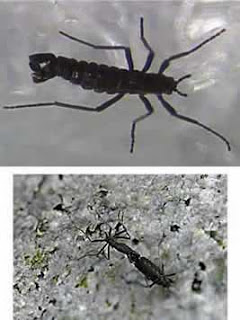 |
Belagica is well adapted to life in Antarctica. It is black to absorb heat, and it is wingless so it won?t be blown out to sea by the strong winds. It has a short egg laying time and adult life span so that it can complete its life cycle in the highly variable summer season. |
Recent evidence shows just how adapted B. antarctica is for the dehydration. The midge has one genetic response to thermal stress, whether it be hot or cold. They turn off some pathways and increase glucose metabolism pathways.
But in dehydration, it has different responses to different patterns of dessication. If it is a rapid dehydration, glucose metabolism pathways are up regulated, but if it is slow and steady, a whole different set of pathways are upregulated, including those for different osmoprotectant molecules (trehelose and proline).
The dry valley temperatures (-10?C to -51?C) could easily cause havoc with the midge?s protein function, including the pathways that protect it from dehydration stress. Heat shock proteins help to stabilize protein function in temperature extremes, usually they are expressed (transcribed from DNA and translated from mRNA) for short periods of time, only when there is an abnormal event. But Belgica?s heat shock proteins are expressed all the time. This is a huge energy investment, and an investment that few animals are willing to make. But in areas with too much salt or too little water, sacrifices must be made.
Next time we will talk about one of the greatest exceptions in biology, an organism that can live in the Atacama Desert, the Jordan Rift Valley, the Great Salt Lake, and even at Antarctica. It's not a bacteria, not a fungus, not a plant, not an animal ? this is one heck of an exception.
Teets NM, Kawarasaki Y, Lee RE Jr, Denlinger DL. (2012). Expression of genes involved in energy mobilization and osmoprotectant synthesis during thermal and dehydration stress in the Antarctic midge, Belgica antarctica. J Comp Physiol B DOI: 10.1007/s00360-012-0707-2
For more information or classroom activities on biological deserts, life in the Dead Sea, and life on Antarctica, see:
For more information or classroom activities on biological deserts, life in the Dead Sea, and life on Antarctica, see:
Biological deserts and gyres ?
http://oceanservice.noaa.gov/facts/deadzone.html
http://news.sciencemag.org/sciencenow/2008/01/25-01.html
http://www.coas.oregonstate.edu/index.cfm?fuseaction=content.display&pageID=589
http://oceanmotion.org/html/background/wind-driven-surface.htm
http://marinedebris.noaa.gov/info/patch.html
http://www.wiserearth.org/article/bea19ef898eca1e2c820690bf8d22640
http://www.sciencedaily.com/releases/2011/02/110208142041.htm
http://disc.sci.gsfc.nasa.gov/oceancolor/additional/science-focus/ocean-color/dead_zones.shtml
http://serc.carleton.edu/microbelife/topics/deadzone/index.html
http://www.msnbc.msn.com/id/4624359/ns/us_news-environment/t/dead-zones-counted-oceans/
http://news.nationalgeographic.com/news/2010/02/100305-baltic-sea-algae-dead-zones-water/
http://www.livescience.com/15341-dead-zone-gulf-mexico-hypoxia-floodsdead-zone-gulf-mexico-hypoxia-floods.html
http://www.ewg.org/reports/deadzone
http://www.physorg.com/news199376811.html
Life around the Dead Sea ?
http://news.nationalgeographic.com/news/2011/09/110928-new-life-dead-sea-bacteria-underwater-craters-science/
http://www.sciencedaily.com/releases/2011/09/110921120331.htm
http://adsabs.harvard.edu/abs/1998SPIE.3441...44O
http://www.wysinfo.com/Dead_Sea/dead_sea_flora.htm
Life in Antarctica -
http://library.thinkquest.org/26442/html/life/
http://www.marinebio.net/marinescience/04benthon/AAlife.htm
http://www.coolantarctica.com/Antarctica%20fact%20file/antarctica_animal.htm
http://schaechter.asmblog.org/schaechter/2010/01/cr.html
http://soundwaves.usgs.gov/2004/04/fieldwork.html
http://www.mobio.com/pages/wiw-antarctica.html
http://www.mcmurdodryvalleys.aq/activities/directory/11-2F12-Science/11-2F12-Biology-and-ecology
- Domains Of Life
The Three Domains of Life Eukarya: This is the most familiar domain to us because it is made up of the kingdoms animalia (animals), plantae (plants), fungi, and protista. They have a huge diversity when it comes to form but they all share fundamental...
- Atp: Cells
This is a picture of the sun :) The sun is the greatest form of energy for living organisms on earth. The sun gives of heat energy which is a form of ATP. Plants convert this energy for photosynthesis, the light is used to produce food for itself. The...
- 7. Ecosystem
Click here for PDFAn ecosystem is a functional unit of nature, where living organisms interact among themselves and also with the surrounding physical environment. Types of ecosystems· Terrestrial ecosystem: Forest, grassland, desert etc· ...
- I Am Your Density -- Life On Ice
Biology concepts ? density of water, latent heat, stratification Ernest Rutherford showed that atoms were mostly space by shooting alpha particles at a sheet of gold foil. Only a few particles struck something solid, most just passed straight through...
- Do You Drink Like A Fish?
Biology concepts ? fish osmoregulation, shark osmoregulation, semelparity, iteroparity The irony of fish drinking is not lost on this café in the Hotel Portofino at Universal Orlando. What I really like is the eye patch.You?d think that fish would never...
